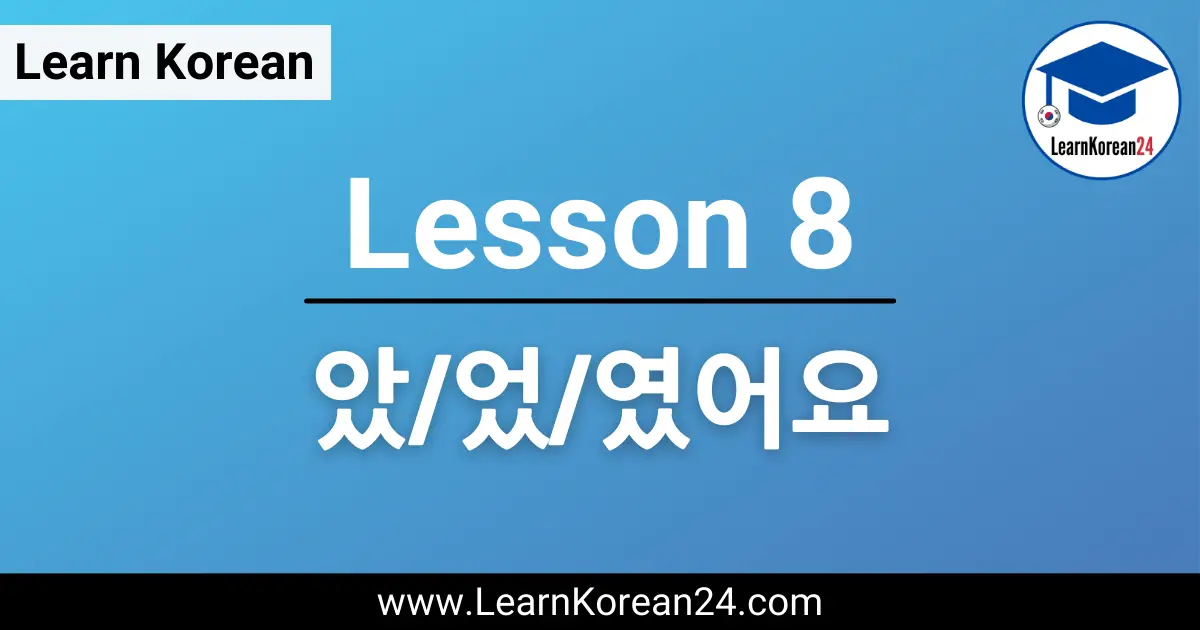Lesson 8: 았/었/였어요
In this lesson, you will learn how to take the dictionary form of a verb and change it into the past tense by adding 았어요, 었어요, or 였어요. If you remember how to change verbs into the present tense from lesson 3, then changing verbs into the past tense is really easy.
Lesson 8:
았/었/였어요
As you learned in previous lessons, the first thing you need to do before conjugating a verb is to take the dictionary form of the verb and remove 다. This will leave you with the ‘verb stem’. For example, the verb stem of 먹다 [meok-da] (to eat) is 먹 [meok].
Once you have the verb stem, the next step is to attach the past tense ending 았어요, 었어요, or 였어요. Just like the present tense, the ending you attach is determined by the final vowel in the verb stem. Let’s look at the rules for each of these endings.
았어요 [a-sseo-yo]
If the last vowel in the verb stem is either ㅏ or ㅗ then we attach 았어요 [a-sseo-yo] to the verb stem to get the past tense. Let’s look at an example:
살다 [sal-da] = to live (dictionary form of verb)
살 [sal] = live (verb stem)
살았어요 [sa-ra-sseo-yo] = lived (past tense)
As you can see, after removing 다 from the verb 살다 you are left with the verb stem 살. The last vowel in 살 is ㅏ and so to make the past tense you must attach 았어요 to make 살았어요.
었어요 [eo-sseo-yo]
If the last vowel in the verb stem is NOT ㅏ or ㅗ then we attach 었어요 [eo-sseo-yo] to make the past tense. Here is an example:
먹다 [meok-da] = to eat (dictionary form of verb)
먹 [meok] = eat (verb stem)
먹었어요 [meo-geo-sseo-yo] = ate (past tense)
였어요 [yeo-sseo-yo]
If a verb ends in 하다, then we add 였어요 [yeo-sseo-yo] to change that verb into the past tense. (Originally 하+였어요 became 하였어요 but over time this became 했어요. All you need to remember is that 하다 verbs in the past tense are 했어요.) Here are some examples:
공부하다 [gong-bu-ha-da] = to study (dictionary form)
공부했어요 [gong-bu-hae-sseo-yo] = studied (past tense)
청소하다 [cheong-so-ha-da] = to clean (dictionary form)
청소했어요 [cheong-so-hae-sseo-yo] = cleaned (past tense)
In this lesson, we covered the basic conjugation rules to use 았어요, 었어요, or 였어요 to change verbs into the past tense. If you want a more detailed look into the past tense and to try some practice exercises, you can check our guide to the Past Tense In Korean. Or if you’re ready to try and change verbs into the past tense on your own, then you can check out this list of 100 common Korean verbs.
STUDY ONLINE WITH KOREAN ARAH!
Ready to take your Korean to the next level?
Get One-on-One Korean lessons from a qualified and experienced Korean language tutor!

